As we have seen in the past, strengthening the muscles of the hip, thigh, and leg are essential for a runner to maintain power and health.
If you are a runner, you probably have tight hip muscles, and that is pretty expected for most of us. But is it just tightness, or are weak hip muscles putting you at serious risk of injury?
The hip muscles control the mechanics of your knee, so if you have weak hip abductor muscles and poor hip rotator muscle strength, your knee is at a higher risk of injury from patellofemoral pain syndrome and iliotibial band syndrome.
Injuries that no runner wants to have to deal with.
Additionally, weak hip muscles have been linked to a host of other running injuries, though less definitively.
Our topic today again looks at hip strength, but in a slightly different light; we show you 5 most helpful hip exercises to prevent injury and improve your hip drive.
Ranging from simple exercises to strengthen hip abductors, to complicated side-stepping and squatting variations to strengthen your hip muscles, our goal is to make those hip muscles powerful to keep those injuries at bay.
First, let’s look at the research so you know these exercises are based on actual data.
What Exercises Strengthen the Hip Flexor Muscles?
An illuminating study published by David Selkowitz, George Beneck and Christopher Powers looked at the relative contributions of three muscles — the gluteus medius, the gluteus maximus, and the tensor fascia lata (TFL) — to hip motion in 11 hip strength exercises.
These three muscles are of interest because they have distinct and significant roles.
- The gluteus medius is the main abductor and external rotator of the hip.
- The gluteus maximus extends the hip and assists with abduction and external rotation.
- The TFL is an abductor of the hip, but because of its positioning, it can also contribute to internal rotation
According to John Fairclough and colleagues in the UK, a tense TFL, because it connects directly to the knee’s lateral side via the iliotibial band, may increase knee strain that could develop into or exacerbate injury. Therefore…
The ideal hip strength exercises are those that maximize the recruitment of the gluteus medius and maximus, while minimizing the recruitment of the TFL.
These were the characteristics whereby Selkowitz, Beneck, and Powers evaluated the 11 different hip exercises.
Using electromyography or EMG, a technique that measures the electrical impulses sent to the muscles, the researchers monitored the muscle activation levels in 20 healthy subjects during the exercises.
To quantify the relative contribution of the glutes and TFL, the researchers calculated the ratio of glute to TFL activation as measured by EMG.
The results showed significant differences in the glute-to-TFL activation ratio among the eleven exercises.
What’s the bottom line?
For injury treatment and prevention; clamshells, sidesteps, single-leg glute bridges and two variants (bent knee and extending knee) of quadruped hip extensions displayed a statistically significant difference in EMG signals in both gluteal muscles when compared to the TFL.
Here are those exercises…
The 5 Best Hip Strengthening Exercises for Runners
RunnersConnect Bonus
Download your FREE Hip Strengthening Exercises Guide.
Download a video version of the 5 most effective hip exercises for runners. You’ll get full descriptions on how to perform and a video to help guide you.
Clamshell exercise with band
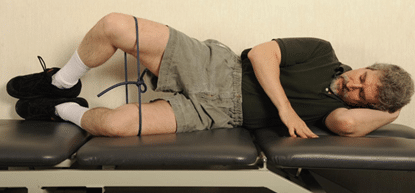
Single leg glute bridge
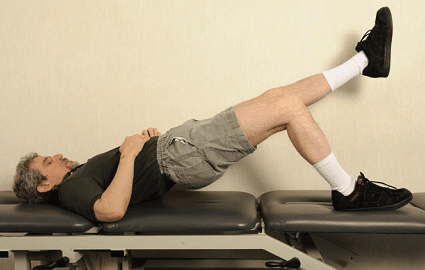
Quadruped hip extension with knee extension
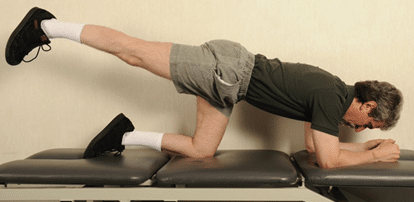
Quadruped hip extension with knee bent
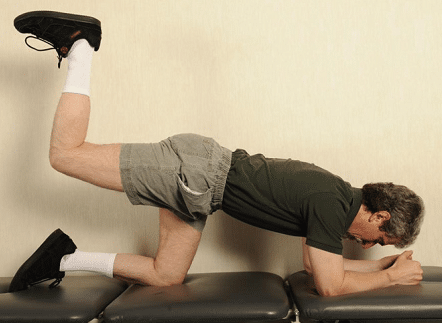
Sidestep
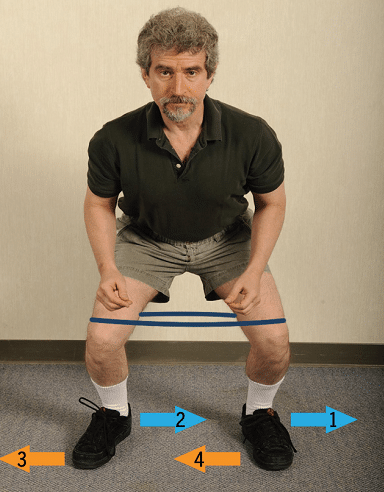
Comparatively, the side-laying leg lift, “hip hike” off a step, squats, and lunges did relatively worse.
That doesn’t mean these exercises should be eliminated from your routine.
They are still valuable and help develop overall hip strength. However, if you’re suffering from excessively weak hips, these five exercises should be your primary focus.
Are there any reasons not to use these exercises?
Unfortunately, the study did have some drawbacks.
The clamshell and sidestep exercises, which both used an elastic theraband for resistance, might have scored artificially well because of the extra resistance provided by the band.
And simply needing a special piece of equipment to do an exercise could be a drawback to some runners.
Additionally, the authors mentioned that muscle activation patterns could be altered in injured runners, necessitating different exercises. That’s a topic that would require another study to investigate.
Nevertheless, the work by Selkowitz, Beneck, and Powers provides a very timely insight into the best hip strength exercises for runners.
A routine based around clamshell exercises using a theraband, side-steps, single-leg glute bridges, and quadruped hip extensions is a very good place to start, either if you have knee or hip injuries currently or would like to prevent developing them in the future.



 <
<

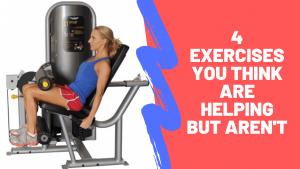
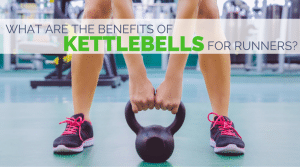
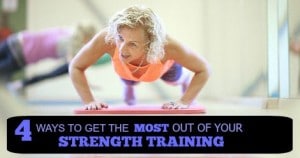

13 Responses
I think bands are pretty easy to buy and use. Even Walmart sells them. I use a lot of band training, simply because they are so easy and the type of resistance is really difficult to train so hard that you can’t recover fast.
for the quadraped exercises, why do them on elbows rather than on hands?
It allows you to isolate and contract the gluteus medius and maximus while minimizing the recruitment of the TFL.
Loving the 2012 JOSPT reference Jeff!
Thanks for the info! I get derailed by frustrating hip issues and found your site searching for solutions, so I for one will incorporate these exercises into my routine.
Other than the clamshell and sidestep, do the other positions have repetitive movement, or are you holding them for 10-12 seconds?
Thanks much.
Great question. You could actually do both (hold or repetitions) – it doesn’t change the exercise or it’s target. I prefer to do repetitions though.
Can you list the repetitions recommended for each exercise for a beginner, intermediate and advanced levels please?
This is probably better, here is our complete hip strengthening for runners guide
I don’t understand why you don’t want to work the TFL. i understand you don’t want it to be tight, but you wouldn’t want it to be weak either, would you? Why not work all the muscles and incorporate stretching for the TFL and whatever else needs it?
I don’t understand– why don’t you want to work the TFL?
i understand you don’t want it to be tight, but why would you want it to be weak, especially when you’re working to strengthen everything else? Wouldn’t it be better to strengthen it too, and include some flexibility work for it?
I’ve done a ton of workouts on those parts of my body… First it started in the right side[ I see so many people suffering in this side This may be because these people are right hand, never the less It is now starting on my left side and I’m dishing it out. It has to be done regardless if I run or not… which I really want to do some day soon again. To be honest there is no other greater feeling than getting up speed and going full blown running.] Now I have gotten that side under control and keeping it that way. I stretch on a regular. Those wanting [ and I know you do ] to get this worked out must do these. It start in the hips but you should strengthen your core. Do plank workouts if that is too hard which they seem o be for me, so What I did was did a 15 minute ab workout routine. Type that into you tube his vids are really good. Do that do leg work lifting your legs. Do it as slow as you can not fast [I did this and it was a mistake] this means lift the leg feel the muscles that allow this t happen, concentrate on them. Notice other body movements and if your core is twisting do not go not allowing it just keep it minimal, as for upper from your sternum to chest and shoulders that is fine that should be twisting. To gain a better understanding of this movement and dis movement stand and put both hands behind your head elbows out do not lock your hands together … EVER never ever do this. That goes for any exercise… do not do that i don’t care if the guru of whatever out there tells ya to do not do it. It will inhibit you from doing more with upper body movement and so on. Just don’t. now place them behind your head… BESIDE… one another 🙂 and now twist one elbow out so that it is in front of your face keeping neck and bottom torso straight. It’s okay for the first few twists if you don’t get it that is totally fine 😀 what matters is that you.. correct it that is all that matters and you get the results … do not worry so much about if you do lock your hands at first or not but you’ll notice now when you do… so yeah that’ that lol. Now the rest.
You want to walk, walk walk walk.. until you start to notice that you are walking differently, You may all the sudden notice you want to lift the each leg and bring it in closer and step out again, this is fine it means your body is adapting to your walking routine and wants to throw in a few extra steps. This is where it gets tricky, you’ll need to stretch and I mean stretch those muscles out daily as they will get sore and worn I should say so much about it but uh once you’re there and it’s done it feels great.
Also allow time to heal rest, nap. I mean it NAP. You won’t believe what a regular nap can do for those sore parts of our bodies and our minds too. Don’t stop doing your regular stretches and start doing others… no that is not good your body knows the old ones as well as the new so keep it up just you can do the new ones a few times a week if you can and then once they are a good age to the old ones less like you did the new ones.
You cannot keep at a muscle group for days at a time throughout the week maybe but you’ll need a few days I’d suggest three max one min to rest. Throughout those days keep up the stretching.
Work your Medius muscle only push it until you feel it working no further. Work your adductors as well if you’re going to work the outside, you are going to have to work the inside as well.
Get a Pillow if you have to, put it between your legs and lightly squeeze once you get the feel and notice the muscles there working and rest and repeat [I say rest then repeat because you’ll feel it after you’ve rested.]
There are better workouts out there for what you want to gain, you have to know what it is your looking to do. Gain weight in the legs, like I said core first then legs. Why? Because a strong trunk means strong roots… too many runners have no clue when it comes to this. Trunk roots and limbs in that order. I’ll say limbs “Arms” would be good for that extra push giving you that much more stability and flexibility.
You’ll also find that the hip problems “Weakness” will travel upwards in the same sense they’ll start in your core go back down to your legs [being feet, foot, knee/s Hip/s – leg/s and so on] this is the body naturally correcting what you haven’t been allowing it over the years. Keeping up with your routine and doing these exercises will work them out. So they will manifest there in the core as being weak you can’t even make one sit up or do some planks that’s because of these weak points, you need to get them worked out and then you can start to really build. Now they’ll work back into the other side of the body, then back up your sides not the middle of your core. Then ugh and this one is well… lets just say it’s painful the shoulders… I wanted to quite I literally had to roar when lol doing this one I made sure no one else was around and would just stretch the crap out of them doing tricep stretches among others. You’ll have to look into what stretches workout or better yet rehabilitate those sections of the body. Don’t go looking into them before hand it’s a lot. Just start walking working things out for yourself. If you can get up and motivated you’re going to have to find out what gets you going… Think big and I mean bigger than the world big, think of something that means more than anything, to everyone no matter who they are or were or will be that is your starting point and go from there… I DID.
This is the best-post I’ve found on this subject, finally one that looks at real scientific studies and that discloses limitations. Well done!